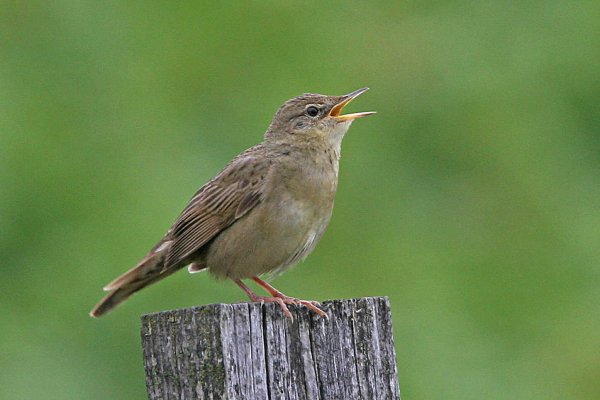BTO publishes peer-reviewed papers in a wide range of scientific journals, both independently and with our partners. If you are unable to access a scientific paper by a BTO author, please contact us.
Search settings
Crossing the Sahara desert:migrating strategies of the Grasshopper Warbler Locustella naevia
Author: Bayly, N.J., Rumsey, S.J.R. & Clark, J.A.
Published: 2011
Although a quarter of Europe’s breeding bird population crosses the Sahara on spring and autumn migration, when, where and how species prepare for and recover from this difficult and dangerous part of their journey remains poorly understood. Recent work by the Wetland Trust and the BTO has used ringing datasets from Portugal and Senegal to explore these questions in the Grasshopper Warbler.
01.01.11
Papers

Climate change and the long-term northward shift in the African wintering range of the barn swallow Hirundo rustica
Author: Ambrosini, R., Rubolini, D., Moller, A.P., Bani, L., Clark, J., Karcza, Z., Vangeluwe, D., du Feu, C., Spina, F. & Saino, N.
Published: 2011
01.01.11
Papers
A review of the relative merits of conserving, using, or draining papyrus swamps
Author: Maclean, I.M.D., Boar, R.R. & Lugo, C.
Published: 2011
01.01.11
Papers
Disentangling the effects of fertilisers and pesticides on winter stubble use by farmland birds
Author: McKenzie, A.J., Vickery, J.A., Leifert, C., Shotton, P. & Whittingham, M.J.
Published: 2011
01.01.11
Papers
Rarity, life history and scaling of the dynamics in time and space of British birds
Author: Sæther, B.-E., Grøtan, V., Engen, S., Noble, D.G. & Freckleton, R.P.
Published: 2011
1. Many patterns in macroecology are closely related to the total abundance of a species in aregion. Here we show that interspecific differences in the pattern of population fluctuations ofBritish bird species can be predicted from knowledge of their overall abundance and some basiclife-history characteristics.2. We identify a rarity syndrome that arises through an increased stochastic influence on populationfluctuations with decreasing population size, mainly resulting from an inverse density-dependenteffect of demographic stochasticity. This syndrome involves an increase in the annual changesin population size with increasing rarity in the United Kingdom.3. The relationship between the magnitude of temporal variation and local mean population sizediffers between species dependent on their life history, i.e. species with larger clutch size and lowersurvival tended to have larger annual changes in population size than low-reproducing long-livedspecies.4. The probability of local disappearance from a study plot depended on the population size andwas hence closely related to the overall abundance of the species in UK. For a given populationsize, this probability was also related to species-specific life-history characteristics, being higher inspecies with larger clutch sizes and smaller survival rates.5. Rareness results in a spatial decoupling of the temporal variation in population size.6. These patterns show that once a species has become rare, e.g. due to human activities, key populationdynamical characteristics will change because of density-dependent stochastic effects, whichin turn are dependent on species-specific life-history characteristics.
01.01.11
Papers